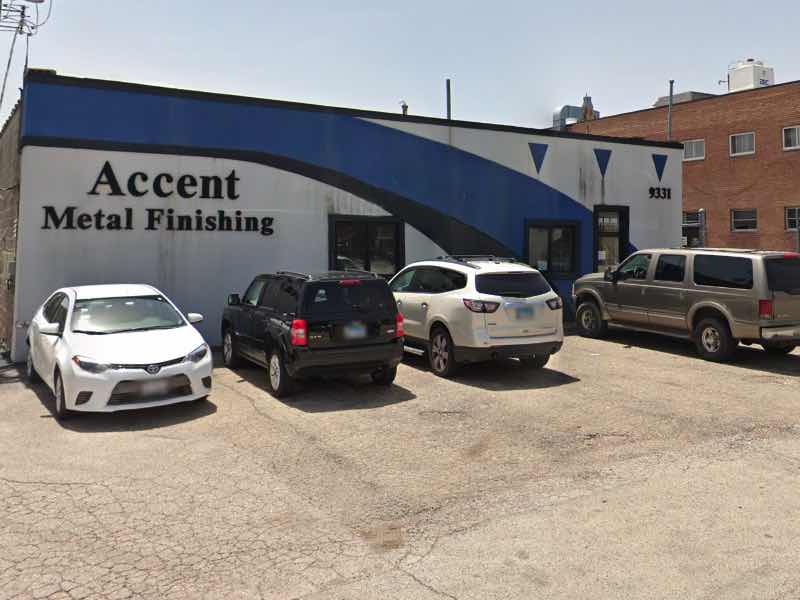While most of Accent Metal Finishing’s competitors in Chicago dabble in fasteners, owner Doug Mangino’s company doesn’t take that route for what he says are obvious reasons.
 Doug Mangino“I don’t want to plate 10 million pieces for next to nothing and be responsible for that,” Mangino says with a sly grin. “I’m not as philanthropic as maybe some other platers seem to be.”
Doug Mangino“I don’t want to plate 10 million pieces for next to nothing and be responsible for that,” Mangino says with a sly grin. “I’m not as philanthropic as maybe some other platers seem to be.”
Instead, Accent chooses to focus on hot black oxide on steel, as well as zinc phosphate conversion coating on steel. A lot of the parts coming through the Schiller Park plant are hand tools and hardware items, such as brackets for furniture and other components.
Large Black Oxide Tanks
What Accent also has is some of the largest black oxides tanks in the region, which gives the smaller shop an edge when it comes to competing with other facilities. The 1,400-gallon tanks are about 9 feet long.
“I’m not sure if there are five other shops around that have black oxide tanks that big,” Mangino says. “But when it is running at 290°F, that is a whole lot of mass to heat up.”
The size of the black oxide tanks allows Accent to get into the large and heavy plating world; the largest part they have run was just under 3,000 pounds.
“Nobody else would touch it,” Mangino says. “If their tank could fit it, then their burner couldn’t recover, or their hoist couldn’t handle it.”
The sheer size of their line has allowed Accent to get a lot of work from other Chicago-area platers and finishers who often can not handle such size and requirements. In turn, Mangino has outsourced some work to other shops in the area as well, making for a big family of cooperation amongst the Chicagoland plating providers.
“We’ve even looked at doubling the size of the tanks because I think there is enough work out there,” he says. “I’d like to be the guy in the middle of the country with tanks 17 feet long and see where that takes us. I’m not sure about it, but I have a hunch.”
Began on the Finishing Chemistry Side
Mangino got his start in the finishing industry by selling chemistry in the 1990s. One of his customers was the former owner of Accent Metal Finishing, who eventually asked him if he would be interested in coming to work for the shop and maybe even look at taking over ownership down the road.
He brushed off the idea of switching jobs — and of becoming a business owner — for a few years, but in 2000 decided to take the position with Accent,
“I was hooked after six weeks,” Mangino says. “That’s when I started to figure out how to purchase the place.”
The previous owner eventually retired in 2004, and after some back and forth on the details of the sale, Mangino became owner in 2008.
Kelly Aylward is the Accent office manager who keeps records and everything straight for Mangino, and Dave Vrenios directs the customer service efforts of the company.
Being Active in NASF Chapter Pays Off
Mangino is very active with the Chicago Midwest Chapter of the NASF, serving in various leadership positions ever since he joined the finishing industry decades ago. His decision to join has been instrumental in the success of his company.
“When I originally joined a long time ago, it was for the wrong reason because I thought there would be great opportunities for us,” Mangino says. “But what I really got from it was building on the network of people that I’ve gotten to know, and not only from a social network, which is important.”
He has used that network in the past when Accent found itself in a tough spot and needed the assistance of others who belong to the chapter.
“If something goes sideways here, then I can call up any of five or so different black oxiders in the area, and they will run my work, and they won’t poach my business,” Mangino says. “I had a tank go down on me, and I called another shop to get some help. They asked me how much to charge, and they ran some of our work for a few weeks until the tank was back up and running.”
Conversely, when the same shop was doing maintenance on its own black oxide line, it reached out to Accent to take some of its work.
“I took the jobs that their customers couldn’t wait on,” Mangino says. “They delivered them, I ran them, and then shipped them right back. That’s why joining the chapter became so valuable to me.”
Conservative Approach to Growth
Mangino also admits that he has leaned toward the conservative side as he has managed his business. For example, while he says he does a fair amount of anodizing that he outsources to partner shops, he has not invested in their own line because of high start-up costs.
Mangino says he has seen other shops over the years that have been overly ambitious in adding equipment and lines, only to see the expansion backfire on them and become a “nightmare in the blink of an eye.”
“You don’t build a company to have customers come to it,” he says. “You build the business, and then upgrade, upgrade, upgrade.”
Mangino estimates that, within 100 miles of his facility in Schiller Park near O’Hare airport, there are about 20 heat treaters, 10 shops doing black oxide, and 40 or more doing zinc plating. That competition means his company has to be lean and service-oriented to stay competitive in the area.
Having said that, Mangino does everything needed of a president and CEO to keep the business running, except “getting dirty,” as he calls it.
“I don’t run the plating lines anymore or run the wastewater treatment,” says Mangino, now 56. “I oversee all of it, but we have some very knowledgeable and skilled people here that can do that very well.”
Balancing Home and Work Life for Plating CEO
As well, Mangino says he has, over the years, developed a very good work and life balance which helps him with the ups and downs of the finishing business. He says he has learned not to take work that troubles him with him and vice versa; he doesn’t bring his home life into the shop while he concentrates on filling customer needs.
What he has learned over the years — and what makes him maintain his sharpness as a CEO and owner of a company — is to not overly worry about issues or concerns that may tip that work/life balance and cause him to spend too many hours at the shop chasing down problems.
“I’ve learned that there is almost nothing that can’t wait until tomorrow if it is time to call it a day,” Mangino says. “I won’t walk out the door in the middle of a project, but the customer may not be any madder tomorrow than they are today. I’ve gotten pretty good at flicking the switch and leaving work at the door.”



































